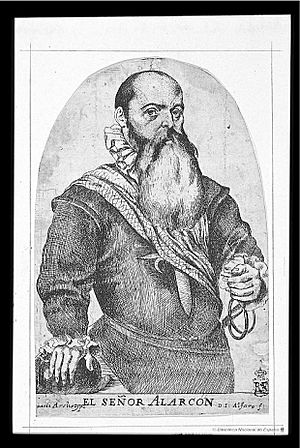Hernando de Alarcón facts for kids
Hernando de Alarcón was a Spanish explorer and sailor from the 1500s. He was born around 1500. He is famous for leading an early trip to the Baja California Peninsula. During this trip, he became one of the first Europeans to travel up the Colorado River from its mouth. He might even have been the first European to reach what is now California.
We don't know much about Alarcón's early life. He was likely born in Trujillo, Spain. This was in the early 1500s. He traveled to the Spanish colonies in the Americas when he was young.
Contents
Exploring New Lands: The 1540 Expedition
By 1540, the Spanish had conquered Mexico. They started sending expeditions north. They hoped to find new riches. They also wanted to find a water passage between the Atlantic and Pacific oceans. The Viceroy of New Spain, Antonio de Mendoza, planned a large land expedition. This trip was led by Francisco Vázquez de Coronado. Its goal was to find the Seven Cities of Cibola. People said these cities were full of gold in the unexplored north.
Alarcón's job was to bring supplies to Coronado's land group. His ships would travel up the Gulf of California.
Setting Sail and Searching for Coronado
Alarcón started his journey from Acapulco on May 9, 1540. He had two ships, the San Pedro and the Santa Catalina. Another ship, the San Gabriel, joined them later.
Alarcón's orders were to wait for Coronado's group. He was supposed to meet them at a certain point along the coast. However, the meeting never happened. Alarcón reached the meeting spot. He left letters there for Coronado. Another explorer named Melchor Díaz found these letters later.
Discovering the Colorado River
Alarcón sailed to the very end of the Gulf of California. He finished the explorations started by Francisco de Ulloa the year before. During this trip, Alarcón proved that there was no open water passage. This meant the Gulf of California was not connected to the Pacific Ocean.
On September 26, he entered the mouth of the Colorado River. He named it the Buena Guía, which means "good guide." He was the first European to travel far up this river. He made many important observations. On a second trip, he likely went past where Yuma, Arizona is today. A map made by one of Alarcón's pilots is the first accurate map. It shows the Gulf of California and the lower part of the Colorado River.
Meeting Native Americans
Alarcón was different from many other Spanish conquistadores of his time. He treated the Indigenous peoples he met kindly. Other explorers were often reckless and cruel.
A writer named Bernard de Voto wrote about Alarcón in 1953. He said, "The Indians had an experience they were never to repeat: they were sorry to see these white men leave." Alarcón wrote about his meetings with the Yuma-speaking people along the Colorado River. He learned about their ways of war, their religion, and how they healed people.
California Historical Landmark
There is a special marker in California called California Historical Landmark No. 568. It is on the west bank of the Colorado River near Andrade. This marker remembers Alarcón's expedition. It marks the spot where non-Indigenous people first saw land within what is now California.
The marker reads:
- NO. 568 HERNANDO DE ALARCÓN EXPEDITION - Alarcón's mission was to provide supplies for Francisco Coronado's expedition in search of the fabled Seven Cities of Cibola. The Spaniards led by Hernando de Alarcón ascended the Colorado River by boat from the Gulf of California past this point, thereby becoming the first non-Indians to sight Alta California on September 5, 1540.
See also
In Spanish: Fernando de Alarcón para niños


